Top 14 Restaurant Reservation Software in 2025
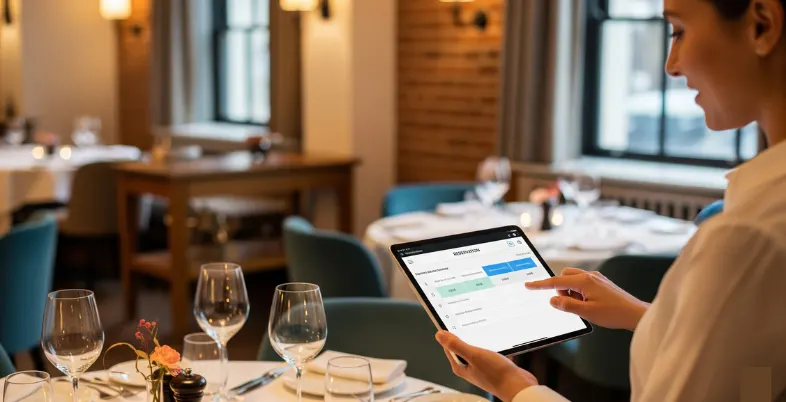
In today’s digital dining landscape, streamlining guest bookings is essential, not optional. Restaurant reservation software has become a crucial tool for hospitality businesses. It helps manage online table bookings, walk-ins, waitlists, guest preferences, and floor plans. Whether you run a fine-dining restaurant that needs to optimize capacity or a local bistro aiming to improve service flow, the right reservation system can significantly increase operational efficiency, reduce no-shows, and enhance the guest experience.
As the restaurant industry responds to rising customer expectations and ongoing labor challenges, table management systems are now essential. They automate bookings, gather data insights, personalize experiences, and improve revenue per seat.
This article delves into the workings, benefits, challenges, and future of restaurant reservation software.
What Is Restaurant Reservation Software?
Restaurant reservation software is a digital tool that lets guests book tables online or through mobile apps. It gives restaurant operators tools to manage and optimize these bookings. These platforms usually connect with websites, Google Search/Maps, social media, and third-party apps, allowing reservations 24/7.
On the operator side, these tools let you set up floor plans, define booking rules, assign tables, manage shift timings, communicate with guests, and track preferences. Some even include features for handling waitlists, managing queues, and integrating with point-of-sale systems. Advanced systems combine loyalty programs, CRM features, and marketing automation to help with guest retention and business growth.
Why Is It Important for Restaurants?
1. Real-Time Availability and Efficiency
With manual bookings, mistakes and double bookings happen often. Reservation software syncs availability in real-time across all booking channels. This improves seat usage and smooths operations during busy times.
2. Reduction in No-Shows
Features like automated confirmations, reminders, pre-payment options, and credit card holds help minimize no-shows and late cancellations. These can financially hurt a restaurant, especially in fine dining.
3. Enhanced Guest Experience
These platforms track customer preferences (like favorite tables, dietary restrictions, and special occasions) to provide personalized service. Loyalty points, waitlist transparency, and review automation also enhance guest satisfaction and retention.
4. Increased Visibility
Many platforms serve as discovery engines. Tools such as OpenTable, Yelp Guest Manager, and TheFork provide integrated marketplaces where potential guests can search and book restaurants by location, cuisine, or occasion.
5. Actionable Insights and Analytics
Most software offers dashboards with analytics on booking trends, table turnover times, peak hours, guest profiles, and campaign performance. These insights guide menu planning, staffing choices, and marketing effectiveness.
Key Features to Look For in Restaurant Reservation Systems
While restaurant reservation systems differ in size and pricing, certain key features set powerful tools apart from basic schedulers:
- Online Booking Widget: Can be embedded on websites, social media, or third-party platforms.
- Table Management and Floor Plan: Visual layouts to organize table assignments and rotations.
- Waitlist and Queue Management: Digital handling of queues with SMS alerts and estimated wait times.
- Guest CRM: Profiles that store visit history, preferences, and reviews.
- Confirmation and Reminder Automation: Emails or SMS to confirm bookings and reduce no-shows.
- Integrations: POS systems, payment gateways, review platforms (like Google and Yelp), and loyalty apps.
- Multi-Venue Support: Essential for restaurant groups and franchises.
- Revenue Optimization Tools: Incorporates yield management, upsells, and pre-payment options.
List of Best restaurant reservation software
1. OpenTable
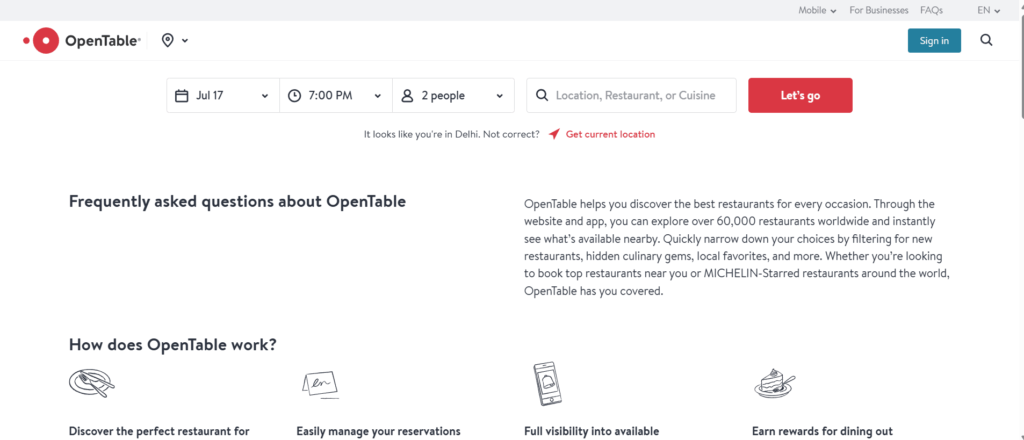
OpenTable is well-known as the top choice in restaurant reservation software, serving over 60,000 venues in more than 80 countries. Since its launch in 1998, OpenTable has developed into a complete guest management system that handles everything from simple online bookings to complex front-of-house operations.
Diners can make reservations directly through OpenTable’s website, mobile app, or through integrations with Google and social media. Restaurants gain strong visibility and reach a global audience of diners. They benefit from real-time table management, digital floor planning, waitlist tools, and guest tagging features that record customer preferences, allergies, and special occasions.
OpenTable also includes built-in marketing tools, like automated email campaigns, loyalty rewards, and diner review management. These tools help restaurants strengthen their customer relationships. Its POS system integrations and detailed reporting dashboards streamline operations and provide restaurateurs with important insights into guest behaviors, booking trends, and revenue analytics.
Features:
- Real-time online reservations from multiple sources
- Automated confirmations, reminders, and waitlists
- Guest CRM with diner history and preferences
- Marketing and loyalty tools for customer retention
- Customizable floor plans and table management
Pricing:
- Starts at $39/month (Basic)
- Core plan at $249/month
2. Resy
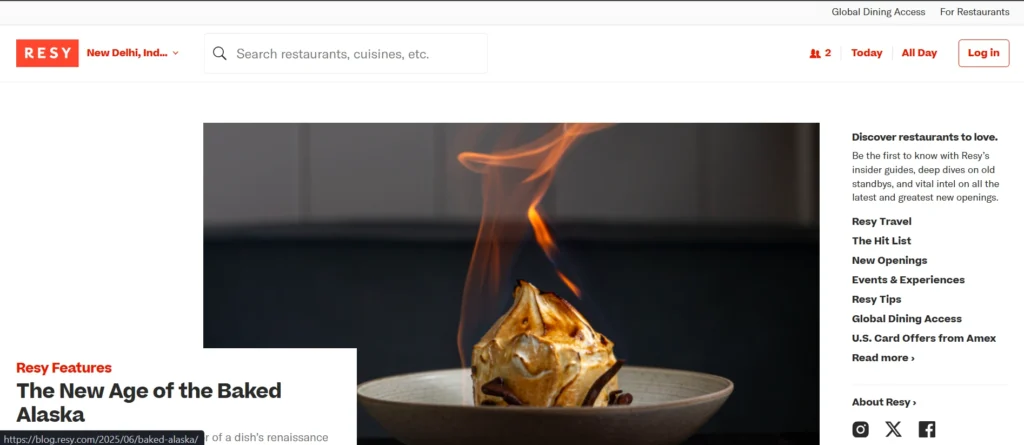
A contemporary platform for booking restaurants, Resy is particularly well-liked by fine dining establishments, Michelin-starred restaurants, and chef-driven eateries. Acquired by American Express, Resy offers an upscale experience for both diners and operators by combining a sleek interface with powerful back-end tools.
Restaurants using Resy gain access to a cloud-based platform, Resy OS, that provides full control over reservations, walk-ins, waitlists, and turn times. Features like automated pacing, cancellation management, and two-way SMS communication help minimize no-shows and improve guest coordination. One of Resy’s notable features is its strong CRM which includes guest tagging, visit histories, preferences, and average spending, allowing for personalized service that fosters long-term loyalty.
With built-in event booking, pre-paid reservation options, and integrations with major POS systems, Resy helps restaurateurs maximize seating and offer excellent service. Access to Amex’s elite customer base also increases exposure among affluent diners, making it a good choice for restaurants needing high service standards.
Features:
- Smart reservation scheduling and inventory control
- Two-way SMS confirmations and reminders
- Guest tagging and CRM profiles
- Event bookings with deposits and prepayments
- Integration with Amex for premium guest discovery
Pricing:
- Starts at $249/month for Resy OS
3. SevenRooms
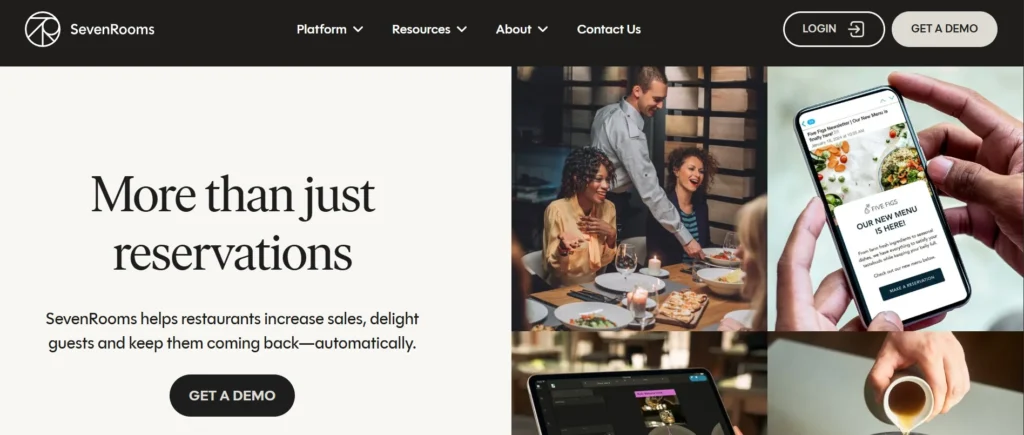
SevenRooms is notable in the restaurant reservation software market for giving restaurants complete control over the guest experience, from discovery to loyalty. Its key feature is the white-label reservation option, allowing customers to book directly through the restaurant’s website while retaining 100% of the guest data.
This ensures full guest ownership and enables venues to create more detailed customer profiles. SevenRooms tracks everything from allergies, seating preferences, and frequency of visits to average spending and review history. The platform seamlessly integrates with POS systems, email marketing tools, and loyalty programs, allowing for highly personalized service, such as offering special seating to a VIP regular or sending targeted promotions after a meal.
SevenRooms provides reservation management, waitlist functionality, online ordering, event bookings, and detailed analytics—all in one place. It suits both single-unit restaurants and global hospitality groups, making it perfect for operators focused on improving service and encouraging repeat business with smarter data usage.
Features:
- White-label reservations with 100% guest data ownership
- In-depth guest profiles and tagging
- Automated waitlist, confirmation, and follow-up emails
- POS and loyalty integrations for personalized service
- Enterprise features for multi-location brands
Pricing:
- Starts at $500/month (custom enterprise pricing available)
4. Yelp Guest Manager
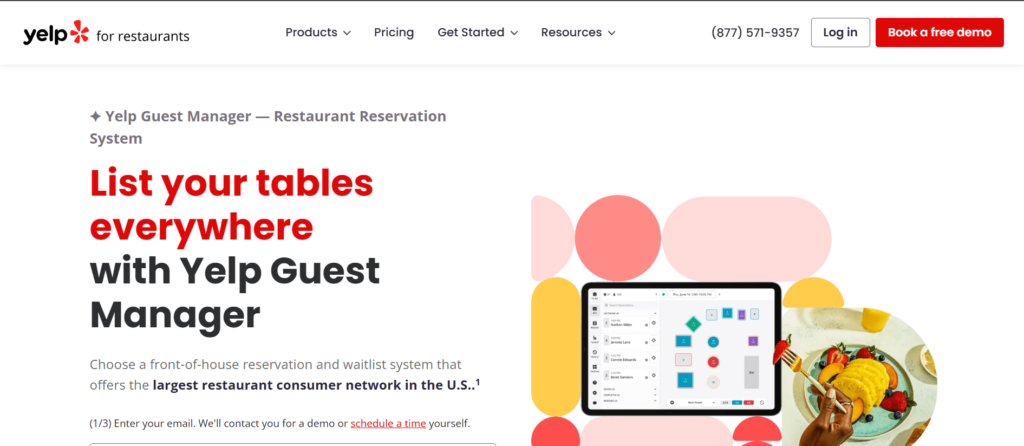
Yelp Guest Manager is a flexible reservation and waitlist system designed for restaurants seeking high visibility and user-friendliness without losing control. Previously known as Yelp Reservations and Nowait, this platform now operates under a single interface that simplifies guest management, walk-in coordination, and digital waitlisting.
Its main advantage is its integration with Yelp’s vast consumer base, providing restaurants free exposure to millions of diners searching for dining options. Guests can make reservations directly through Yelp, Google, or the restaurant’s website, while restaurants manage their floor plans, turn times, and server rotations.
Yelp Guest Manager also features real-time SMS updates, seating analytics, and guest notes to enhance the personalized experience. The intuitive setup makes it an attractive choice for fast-casual, casual dining, and mid-tier full-service restaurants that value simplicity, speed, and visibility.
Features:
- Reservation and waitlist management in one app
- Integration with Yelp’s review and search ecosystem
- Real-time SMS updates for guests
- Floor plan and seating analytics
- Easy setup for casual and busy restaurants
Pricing:
- Starts at $99/month
Also Read: Food Truck Name Ideas
5. Hostme
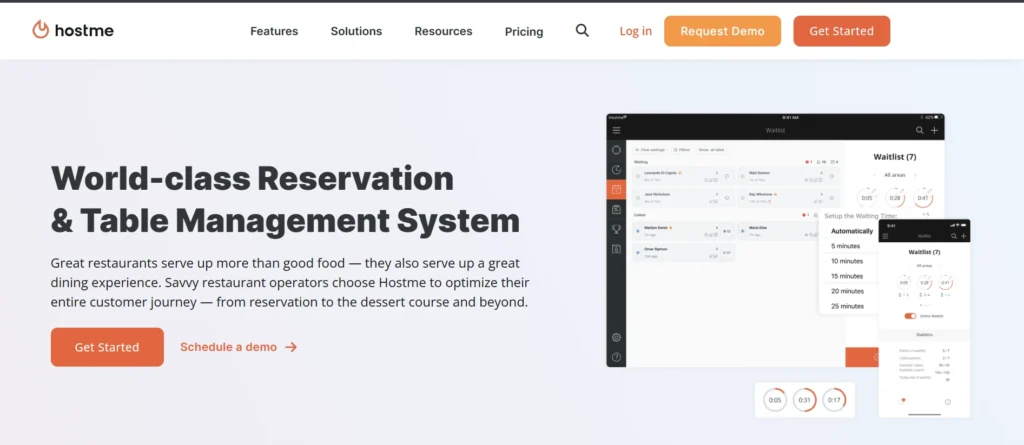
Hostme is a budget-friendly restaurant reservation software designed for small to mid-sized venues, aiming to optimize seating and minimize walk-out rates. It supports both online and walk-in reservations through various digital channels, including the restaurant’s website, Google, Facebook, and QR codes.
Real-time table status tracking, dynamic waitlist management, and an easy-to-use drag-and-drop floor plan management interface are some of Hostme’s primary features. This solution is especially strong for restaurants requiring multi-language support and no-show deterrents, as it offers credit card holds and automated cancellation policies.
Hostme also lets restaurants collect post-dining feedback, store detailed guest preferences, and automate guest notifications via email or SMS. Its ease of use and affordability have made it a favorite among independent restaurants, small chains, and international eateries looking for a customizable, mobile-first reservation tool.
Features:
- Online reservations through website, Google, and social media
- Automated waitlist and SMS notifications
- Customizable seating rules and floor plans
- Guest feedback and rating collection
- No-show protection through credit card holds
Pricing:
- Starts at $39/month (with 14-day free trial)
6. Tock
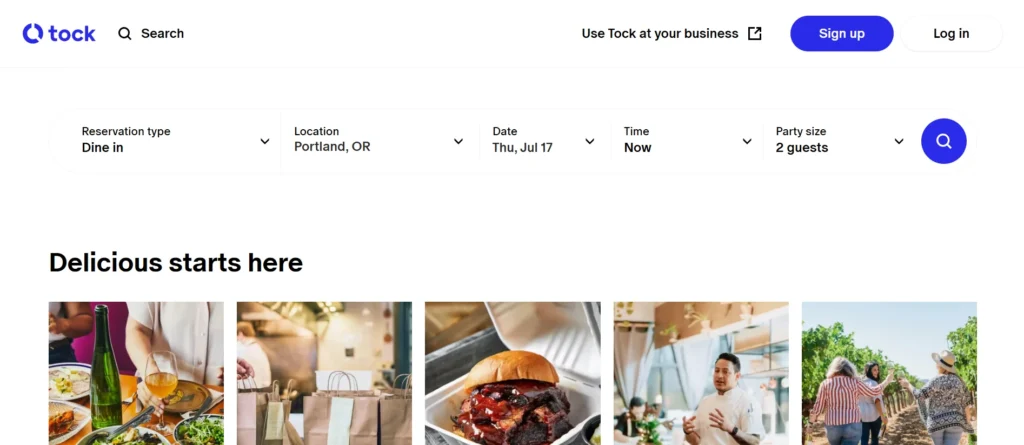
Tock is a modern restaurant reservation platform focused on experiential dining, tasting menus, pop-up events, and fine dining. Co-founded by one of the creators of Alinea and now part of Squarespace, Tock separates itself from traditional booking systems by allowing restaurants to offer reservations with prepayments, deposits, or ticketed experiences.
This approach reduces no-shows and aligns guest expectations with the dining format. Whether it’s a prix-fixe meal, chef’s table, or seasonal event, Tock enables restaurants to customize their booking processes and pricing tiers. The platform also provides robust tools for managing walk-ins, waitlists, and large party bookings.
Additionally, Tock includes a CRM system that allows restaurants to track guest preferences, order histories, and visit frequencies, making it easier to create personalized dining experiences. It integrates with POS systems and offers analytics for optimizing table turnover and revenue per seat. With its focus on operational control and guest journey design, Tock is particularly popular among restaurants wanting to elevate and monetize their unique offerings.
Features:
- Prepaid and ticketed reservation options
- Customizable event booking and tiered pricing
- Guest CRM with history and visit insights
- No-show deterrence through deposits and payments
- POS integrations and performance analytics
Pricing:
- Starts at $199/month (also has a 3% fee per prepaid reservation)
Also Read: Agriculture Business Ideas
7. Tablein
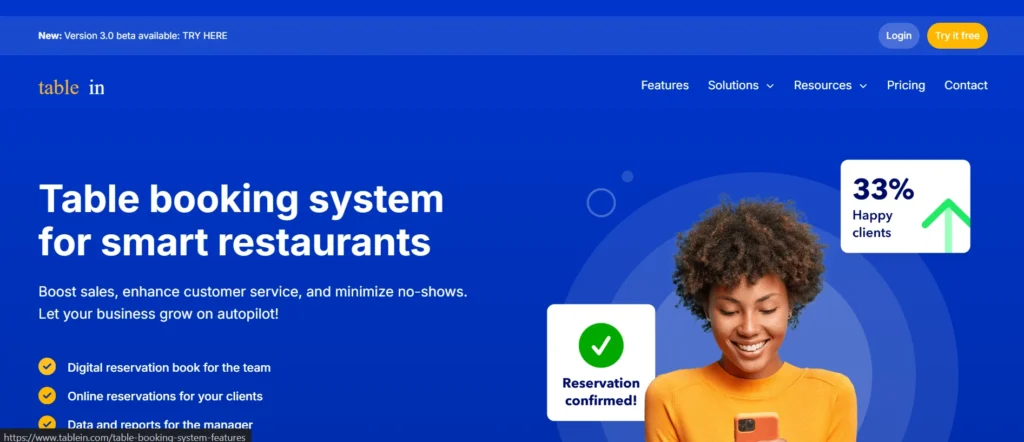
Tablein is a simple, cloud-based restaurant reservation software ideal for small and medium-sized restaurants, cafes, and bistros needing an effective way to manage bookings. It stands out for its clean interface, quick onboarding, and easy-to-use tools aimed at restaurant operators without dedicated tech teams.
Tablein allows customers to make real-time online reservations directly from the restaurant’s website or social media, while managers can block tables, set buffer times, and avoid overbooking. The system collects guest information, preferences, and past visit records, providing basic but useful CRM capabilities. Restaurants can customize their reservation rules, such as group size limits and time slots, and even request online deposits to secure tables.
Automated confirmations and reminder emails help reduce no-shows, while real-time reporting gives insights into seating trends, occupancy rates, and customer frequency. Tablein is well-suited for restaurants with moderate volume looking for reliability without complexity.
Features:
- Real-time bookings through web and social channels
- Custom reservation rules and seating limits
- Simple guest data management
- Email confirmations and reminders
- Clean dashboard and mobile access
Pricing:
- Starts at $49/month
8. Eat App
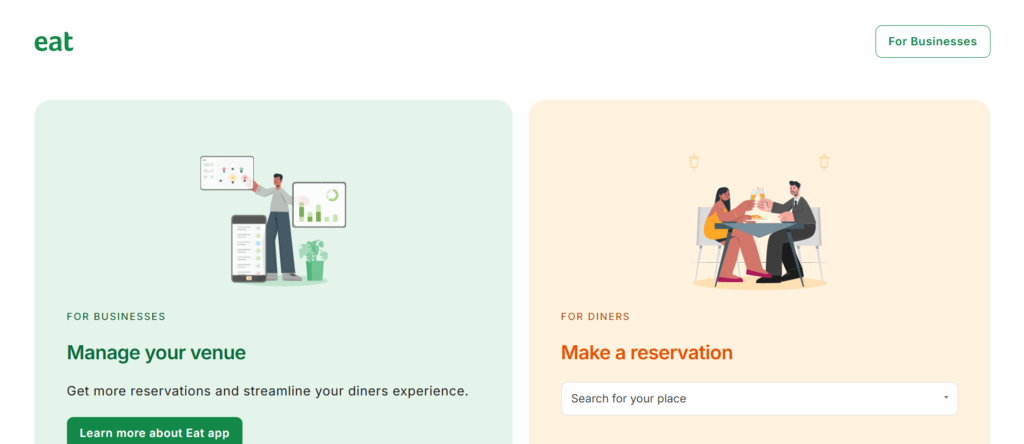
Eat App is a powerful restaurant-first reservation and guest management tool made to boost customer satisfaction and front-of-house productivity. It features a streamlined interface that centralizes table reservations, waitlists, walk-ins, and floor planning all within one dashboard. Restaurants can receive bookings directly through their website, social media, Google Reserve, and custom landing pages.
Eat App’s standout feature is its data-rich CRM system that allows for advanced guest segmentation, including loyalty frequency, average spending, occasion types, and dietary preferences. With integrations for popular POS systems, it enables automated guest tagging and revenue tracking. Restaurants can also use Eat App’s built-in email marketing features to send personalized promotions or thank-you messages after dining.
Additionally, the software provides detailed operational analytics, empowering restaurants to make data-driven choices about staffing, turn times, and capacity optimization. Eat App is a scalable solution utilized by everyone from independent restaurants to major hospitality groups in over 60 countries.
Features:
- Multi-channel reservation handling
- In-depth guest profiling with segmentation
- POS integration for revenue tracking
- Automated marketing and guest follow-up
- Real-time table and waitlist management
Pricing:
- Starts at $129/month
9. Wisely (Now Part of Olo)
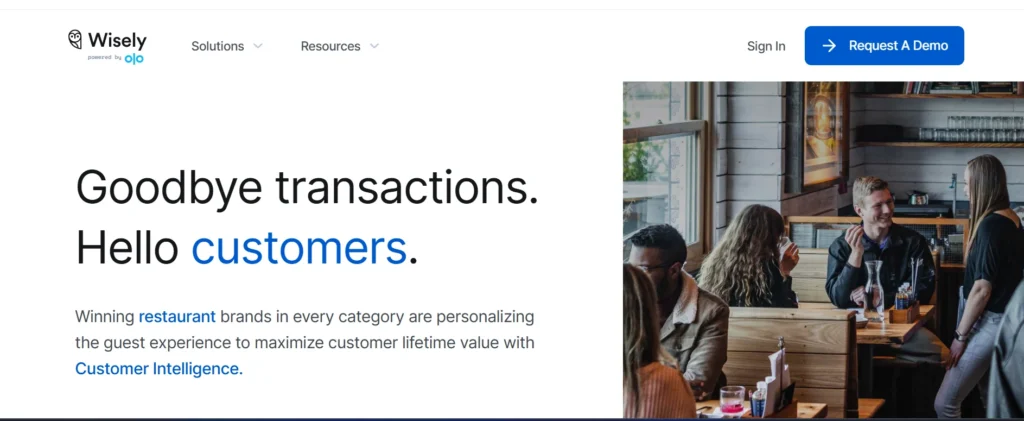
Wisely is a guest engagement and reservation software aimed at restaurants seeking deep customer insights and efficient marketing automation. Now integrated into Olo’s broader restaurant tech ecosystem, Wisely provides strong tools for waitlist management, capacity planning, and guest personalization across in-store and online interactions.
The reservation system offers real-time table inventory and integrates with the restaurant’s website, Yelp, Google, and social media. Wisely’s enterprise-level data capabilities allow restaurants to segment guests based on visit behavior, transaction history, and lifetime value, using these insights to launch automated SMS and email campaigns.
It also enables in-service tagging (VIP, first-time guest, etc.) and gathers feedback through post-visit surveys. With a focus on customer retention and marketing that drives ROI, Wisely is particularly effective for multi-unit restaurants and upscale casual dining brands aiming to build loyalty and increase revenue.
Features:
- Guest reservation, waitlist, and CRM in one
- Enterprise analytics and data segmentation
- Marketing automation through email and SMS
- VIP tagging and personalized service prompts
- Feedback tools and post-dining surveys
Pricing:
- Custom pricing (based on usage and integrations)
10. Carbonara App
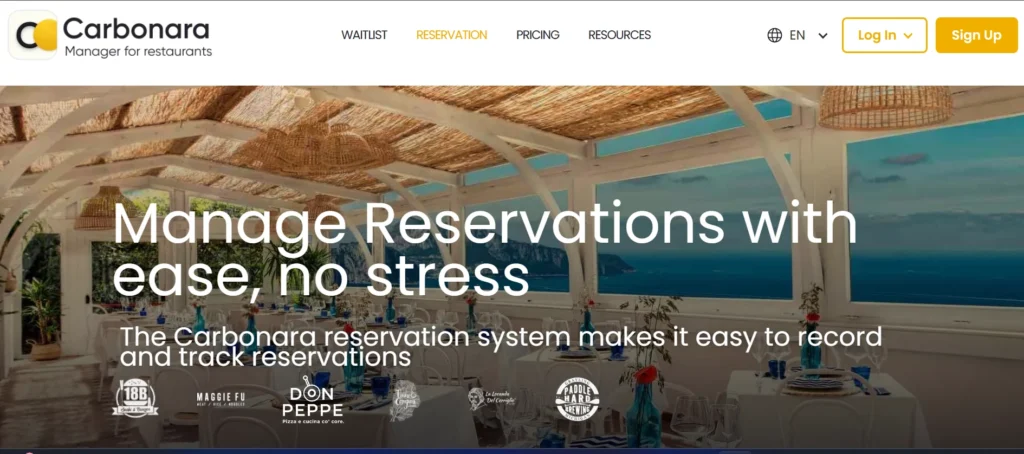
Carbonara App is an innovative, no-cost restaurant waitlist and reservation app designed for small restaurants, cafes, and fast-casual venues. Unlike most reservation tools that require monthly fees, Carbonara provides its core features at no charge, making it accessible to budget-conscious operators or new businesses.
The app allows digital waitlisting where guests join the queue remotely by scanning a QR code or sending a text message. For reservations, the system supports simple online booking widgets that restaurants can place on their website or Facebook page. Carbonara features SMS notifications for wait times, table readiness, and reservation reminders.
It also provides for table management with status updates, custom seating rules, and party size limits. While it lacks high-end CRM or payment features, its simplicity and affordability make it a great fit for small, fast-paced establishments seeking digital capabilities without a contract.
Features:
- Free waitlist and reservation management
- No-show reduction through SMS alerts
- QR code access and digital queue joining
- Table status tracking and seating logic
- Easy setup with no contracts or fees
Pricing:
- Free
11. ResDiary
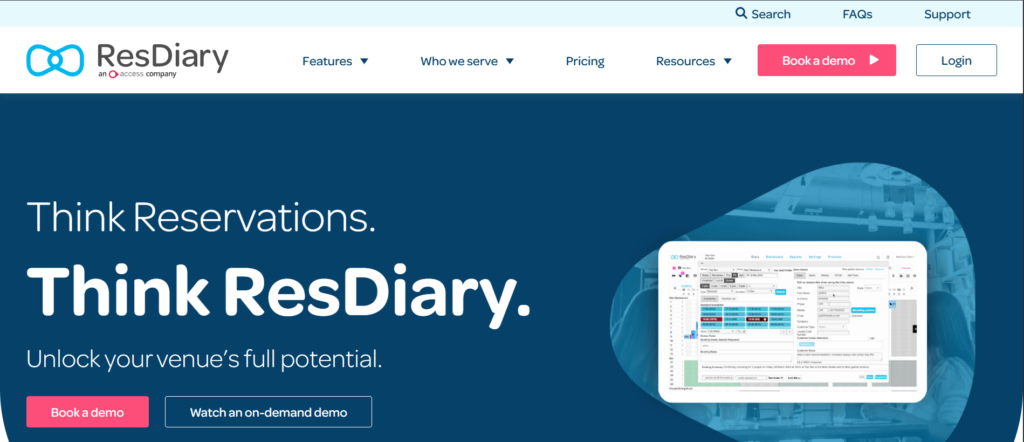
ResDiary is a trusted table management and reservation platform used by over 10,000 restaurants in more than 60 countries. It allows restaurants to customize their bookings and maintain full control over their data. This prevents reliance on third-party platforms and removes per-cover fees. Its real-time reservation software that works well with the restaurant’s website, Google, and social media pages, enabling diners to book any time.
Managers can set rules for shifts, floor plans, buffer times, and promotional offers directly in the platform. ResDiary also has marketing tools for sending newsletters, discount codes, and SMS campaigns to specific guest lists. Additional features like table optimization, waitlist management, pre-ordering, and yield management help restaurants increase revenue per seat.
With built-in PCI-compliant payment tools and connections to POS and loyalty systems, ResDiary is especially useful for multi-location brands and fine dining restaurants that need flexibility and marketing control.
Features:
- No per-cover fee with full data ownership
- Customizable reservation widgets and rules
- Marketing tools with CRM segmentation
- Shift and yield management
- Integrates with POS, loyalty, and payment gateways
Pricing:
- Starts at $109/month
Pricing:
- Starts at $39/month plus per-cover fees based on the plan
12. TableAgent
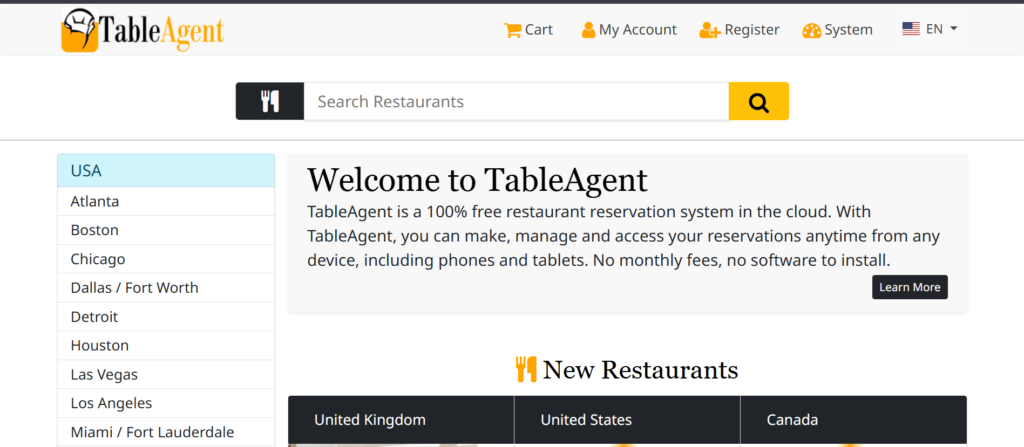
TableAgent is a free, cloud-based reservation software that aims to help restaurants, cafés, and bars lower their booking process costs. Used by thousands of businesses around the world, it has a simple, list-based interface similar to a digital reservation book.
The platform lets restaurants easily manage reservations, walk-ins, and waitlists without monthly or per-cover fees. For extra convenience, it includes an embeddable booking widget that can be added to any website using iFrame, allowing customers to book directly from the restaurant’s site.
While TableAgent lacks advanced table-layout views and guest CRM, it meets all essential needs and offers optional upgrades like SMS messaging and payment features.
Features:
- Real-time booking widget integrated into your website
- Reservation, walk-in, and waitlist management
- Party-size control, basic reporting, and cover reports
- Optional SMS confirmation service ($20/month)
- Optional payment processing: $1 per transaction or $29/month unlimited
Pricing:
- Free basic system with no monthly fees or per-reservation charges
- Payment add-on: $1 per transaction or $29/month for unlimited plan
- SMS messaging: $20/month
- Unlisting (private account): $30/month
13. GloriaFood (by Oracle)
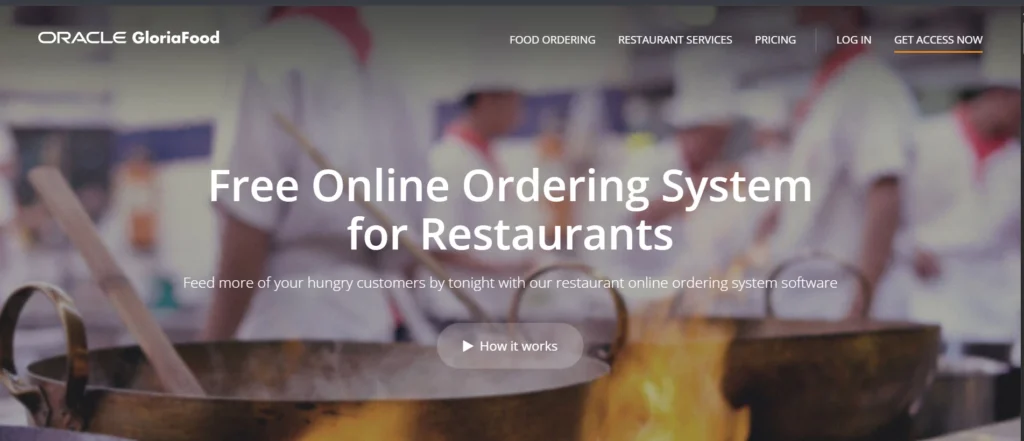
GloriaFood, part of Oracle’s MICROS suite, is a free online ordering and table reservation tool aimed at small to medium-sized restaurants. It is best known for its online food ordering tools but also offers a user-friendly reservation widget that can be added to any website or Facebook page.
Restaurants can set opening hours, table limits, buffer times, and party size ranges to fit their operation. Reservation confirmations and reminders are sent automatically via email or SMS, and managers get real-time notifications for each booking. For businesses using Oracle POS systems, GloriaFood provides integrations linking reservation and order data to customer profiles.
This platform is especially popular among restaurants moving from manual to digital workflows without the high costs of full-featured SaaS tools.
Features:
- Free reservation widget for websites and social media
- Real-time booking notifications
- Email/SMS confirmation system
- Table configuration and time-slot management
- Integration with Oracle MICROS POS
Pricing:
- Free with paid upgrades for advanced features
14. Wix Restaurant Reservations
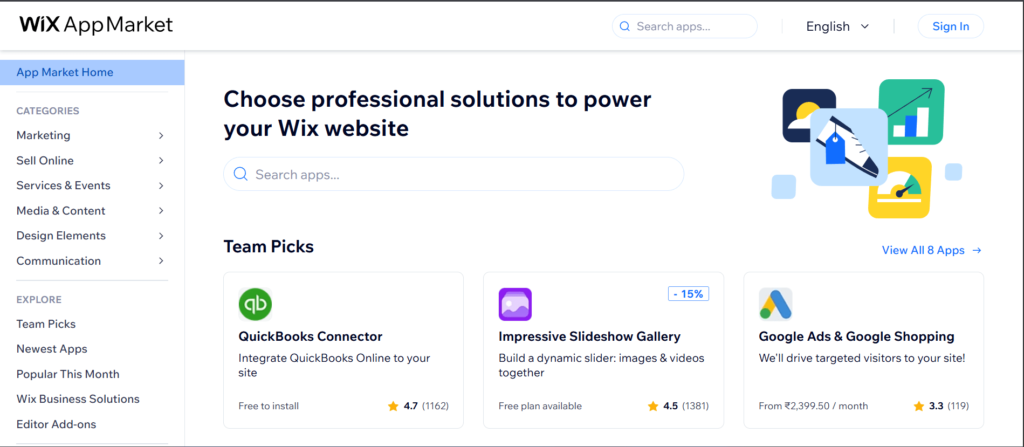
Wix Restaurant Reservations is a table booking tool that comes with the Wix Restaurants system. It’s great for restaurants that already have their sites on the Wix platform. It is easy to use and connects directly to a Wix website. This allows customers to book tables through your site, with options to customize reservation rules and create visual floor plans. As part of Wix’s restaurant tools, it works well with online ordering, menu management, and promotions in one dashboard.
With the reservation feature, you can set limits on party sizes, enforce turnover times, and decide if bookings are automatically confirmed or need manual approval. You can collect prepayments or request approval for large group bookings. While waitlist functionality isn’t available yet, updates are in the works to improve this feature. The system operates entirely through your Wix dashboard or mobile app, and there’s no need for integration with third-party reservation platforms.
This tool is especially beneficial for smaller, Wix-based restaurants that want an all-in-one solution without having to install separate reservation software. Since it’s part of Wix’s Premium business plans, it’s a practical option for venue owners already using Wix for their menus, online ordering, and marketing tools.
Features:
- Embedded reservation widget on Wix site
- Control over party size, time slots, and turnover pacing
- Option to require manual approval or allow auto-confirmation
- Visual floor plan for table assignment
- Pre-payment and deposit support for large groups
Pricing:
- Starting at around $17 per month on the basic business plan.
Challenges Restaurants Face Without Reservation Software
Restaurants without a digital reservation system face significant disadvantages. Manual processes create time-consuming booking calls, paper logs, overbooking mistakes, and limited operational visibility. Common issues include:
- Inefficient Table Turnover: Manual seating wastes time and lowers daily covers.
- Poor Guest Communication: Guests may not know about table availability, delays, or closures.
- Inability to Scale: Managing reservations across multiple locations or staff shifts leads to inconsistencies.
- No Access to Data: Without tracking booking behavior, repeat visits, or revenue per table, making data-driven decisions is impossible.
- Higher No-Show Rates: Without automation, there are no reminders or cancellation safety nets.
These issues can greatly affect profitability, guest satisfaction, and staff productivity.
Trends Driving the Restaurant Reservation Software Market
1. Integration With Online Ordering and POS
After the pandemic, many platforms have developed into all-in-one solutions that link reservations with delivery, POS, and contactless payments. This unified technology streamlines restaurant operations and guest experiences.
2. Predictive AI and Smart Scheduling
AI-driven recommendations help restaurants optimize shifts, predict peak times, and manage table spacing or pricing based on demand. Smart queue systems also provide more accurate wait time estimates.
3. Focus on Guest Data and Personalization
Guest-centered features are increasingly in demand. CRM tools that track allergies, visit frequency, favorite wines, or seating preferences enable tailored experiences and foster customer loyalty.
4. Voice and Chatbot Integrations
Newer systems are using voice assistants (like Google Assistant) and WhatsApp chatbots to manage booking inquiries and confirmations, reducing the need for human involvement.
5. Sustainability and Digital Menus
Some platforms are adding features like digital menu previews, pre-ordering, and feedback collection to minimize waste and enhance operational efficiency. These features attract eco-conscious diners and support staff-light setups.
How to Choose the Right Reservation Software
Selecting the right platform depends on several operational factors:
- Size of Your Restaurant: Larger venues need advanced table layouts, staff assignments, and CRM features.
- Booking Volume: High-traffic venues may benefit from dynamic pricing or yield management tools.
- Online Discovery Needs: If attracting new customers via apps is important, platforms with built-in diner marketplaces are advantageous.
- Budget and ROI: Assess monthly covers, no-show rates, and conversion metrics to understand the software’s financial impact.
- Integration Stack: Make sure it works with your POS, ordering, or loyalty systems.
Conclusion
Restaurant reservation software has become crucial for modern hospitality businesses. It offers much more than just booking capabilities; it streamlines workflows, improves guest experiences, enhances marketing efforts, and increases profitability. For single-location cafes to global fine-dining chains, selecting the right reservation platform can distinguish between reactive operations and proactive, data-driven success.
Investing in reliable software tailored to your restaurant’s needs not only boosts efficiency but also builds long-term customer loyalty, optimizes revenue, and fosters a reputation for excellence in hospitality.
FAQs
1. Can restaurant reservation software help reduce no-shows?
Yes, most tools offer automated reminders, confirmation links, and even pre-payment options that significantly lower no-show rates.
2. Do these systems work for walk-in customers too?
Yes, many platforms manage walk-ins, digital waitlists, and queue estimation tools along with online bookings.
3. Is it suitable for small restaurants?
Absolutely. Many systems have basic plans designed for small businesses with low monthly costs or even free options.
4. Do I need technical expertise to set it up?
No, most platforms are user-friendly and provide onboarding, live support, or tutorials to help with setup and integration.
5. Can these tools integrate with POS or delivery platforms?
Yes, top solutions connect with POS systems, payment processors, loyalty programs, and even delivery services for unified management.